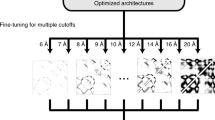Abstract
The profile of contact numbers of amino acid residues in proteins contains important information about the protein structure and is connected with the accessibility of residues to solvent. Here we propose a method for predicting the profile of contact numbers of residues in protein from its amino acid sequence. The method is based on regression using a neural network algorithm. The algorithm predicts two types of profiles, namely, the total number of contacts and the number of close contacts with the neighbors in the chain. The Pearson coefficient of correlation between the actual and predicted values of total contact numbers amounted to 0.526–0.703. As for the number of close contacts, this coefficient was higher (0.662–0.743) for all the considered threshold contact distances (6, 8, 10, and 12 Å). The program for prediction of contact numbers CONNP is available at http://wwwmgs2.bionet.nsc.ru/reloaded.
Similar content being viewed by others
References
K. Nishikawa and O. Ooi, Int. J. Pept. Protein. Res. 16(1), 19 (1980).
M. A. Rodionov, S. G. Galaktionov, and A. A. Akhrem, Dokl. Akad. Nauk SSSR 261(2), 756 (1981).
A. Rost and C. Sander, Proteins 20(3), 216 (1994).
K. Nishikawa and Y. Matsuo, Protein Eng. 6(8), 811 (1993).
P. Fariselli, O. Olmea, A. Valencia, and R. Casadio, Proteins 45(5), 157 (2001).
P. Fariselli and R. Casadio, Proceedings of the International Conference of Intelligence Systems in Molecular Biology, 8, 146 (2000).
G. Pollastri, P. Baldi, P. Fariselli, and R. Casadio, Proteins 47(2), 142 (2002).
A. R. Kinjo, K. Horimoto, and K. Nishikawa, Proteins 58(1), 158 (2005).
Z. Yuan, BMC Bioinformatics 6, 248 (2005).
A. R. Kinjo and K. Nishikawa, BMC Bioinformatics 7, 401 (2006).
S. Ahmad, M. M. Gromiha, and A. Sarai, Proteins 50(4), 629 (2003).
D. O. Jones, J. Mol. Biol. 292(2), 195 (1999).
H. M. Berman, J. Westbrook, Z. Feng, et al., Nucleic Acids Res. 28(1), 235 (2000).
A. Andreeva, D. Howorth, S. E. Brenner, et al., Nucleic Acids Res. 32 (Database issue), D226 (2204).
S. K. Riis and A. Krogh, J. Comput. Biol. 3, 163 (1996).
P. Baldi and S. Brunak, Bioinformatics: The Machine Learning Approach, 2nd edition (MIT, Cambridge, MA, 2001).
S. F. Altschul, T. L. Madden, A. A. Schaffer, et al., Nucleic Acids Res. 25(17), 3389 (1997).
D. E. Rumelhart, G. E. Hinton, and R. J. Williams, in Parallel Distributed Processing, Ed. by D. E. Rumelhart and J. L. McClelland (MIT, Cambridge, MA, 1986), Vol. 1, pp. 318–362.
Author information
Authors and Affiliations
Corresponding author
Rights and permissions
About this article
Cite this article
Afonnikov, D.A., Morozov, A.V. & Kolchanov, N.A. Prediction of contact numbers of amino acid residues using a neural network regression algorithm. BIOPHYSICS 51 (Suppl 1), 56–60 (2006). https://doi.org/10.1134/S0006350906070128
Published:
Issue Date:
DOI: https://doi.org/10.1134/S0006350906070128




